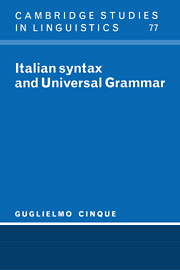Book contents
- Frontmatter
- Contents
- Introduction
- 1 On extraction from NP in Italian
- 2 On the theory of relative clauses and markedness
- 3 Bare quantifiers, quantified NPs, and the notion of operator at S-structure
- 4 On si constructions and the theory of arb
- 5 Ci si
- 6 On a difference between English and Italian “Complement Object Deletion” constructions
- 7 Ergative adjectives and the Lexicalist Hypothesis
- 8 The pseudo-relative and ACC-ing constructions after verbs of perception
- 9 On leftward movement of tutto in Italian
- 10 On the evidence for partial N-movement in the Romance DP
- References
- Index
4 - On si constructions and the theory of arb
Published online by Cambridge University Press: 01 October 2009
- Frontmatter
- Contents
- Introduction
- 1 On extraction from NP in Italian
- 2 On the theory of relative clauses and markedness
- 3 Bare quantifiers, quantified NPs, and the notion of operator at S-structure
- 4 On si constructions and the theory of arb
- 5 Ci si
- 6 On a difference between English and Italian “Complement Object Deletion” constructions
- 7 Ergative adjectives and the Lexicalist Hypothesis
- 8 The pseudo-relative and ACC-ing constructions after verbs of perception
- 9 On leftward movement of tutto in Italian
- 10 On the evidence for partial N-movement in the Romance DP
- References
- Index
Summary
There are some peculiar restrictions on the occurrence of impersonal si in untensed and tensed clauses with specific time reference in Italian that have gone largely unnoticed in the literature and are not expected under the standard analysis of the construction. I will show that they are in fact simple consequences of very general principles, Theta Theory and Case Theory, under a finer analysis of impersonal si: one that provides, among other things, for two distinct uses of the morpheme, an argumental and a non-argumental one.
Although it introduces a further distinction in the class of si constructions, this analysis is in principle compatible with the program of unifying all uses of si (impersonal, middle, and reflexive). The unification approach and the one pursued here simply set themselves at different levels of abstraction. A question to which we return below.
After reviewing the fundamental restrictions on impersonal si in untensed clauses (section 1), we will suggest an analysis which accounts for them via principles that are already independently justified (section 2). In section 3, the differences in the interpretation of impersonal si in finite clauses with specific and generic time reference will be discussed and related to the same analysis in interaction with a more general theory of “arbitrary” (arb) interpretation. Section 4 contains a reexamination of so-called passive si, reinterpreted in part in the light of the preceding results on impersonal si. In section 5, some (provisional) comparative remarks are made on impersonal si constructions in other Romance languages.
- Type
- Chapter
- Information
- Italian Syntax and Universal Grammar , pp. 121 - 192Publisher: Cambridge University PressPrint publication year: 1996



